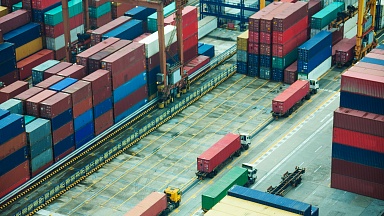In the first half of 2025, global trade showed signs of recovery, with total volume increasing by USD 300 billion. After a downturn observed since late 2023, global trade value grew by approximately 1.5% in the first quarter of 2025, with a further increase of up to 2% projected for the second quarter. While trade volumes in goods increased by only 1%, rising prices became the main driver of overall value growth.
Developed economies demonstrated the most notable positive trends: U.S. imports grew by 14%, and European Union exports rose by 6% compared to the previous quarter. At the same time, developing countries — especially those outside East Asia — faced a decline, with imports falling by 2%.
China remains a key player in global trade. Despite a quarterly and year-on-year decrease in imports in Q1 2025, merchandise exports increased by 6%, and service exports grew by 18% year-on-year. The growth of Chinese exports is supported by active trade within the Asia-Pacific region and with Africa. A stable recovery began in Q2 2024 and continues into 2025.
Russia shows the opposite trend. In the first quarter of 2025, imports decreased by 11%, and exports by 9% quarter-on-quarter. However, total exports increased by 1% year-on-year. In the services sector, imports fell by 4% and exports by 1%, though annual growth ranged between 3% and 6%. These figures reflect the ongoing adaptation of the Russian economy to the current geopolitical environment and sanctions pressure.
Trade between Asia and Europe remains resilient amid a volatile global environment. Europe recorded growth in Q1 2025 thanks to external trade, while Central Asia and other parts of Asia (including the Pacific region) faced a decline. Ties between East Asia and Europe remain crucial for maintaining trade flows, especially in the context of geo-economic fragmentation.
The trade balance has also shifted. The United States widened its trade deficit, while China and the European Union increased their trade surpluses. China remains the world’s largest holder of a positive goods trade balance. The U.S. trade deficit with China and the EU remains the most significant, whereas its deficit with Russia is considerably lower.
In terms of trade dynamics, there has been a shift in focus. While developing countries were the main growth drivers after 2022, their share in global trade growth has decreased at the beginning of 2025. The exception is East Asian countries, including China, which have shown a recovery in export activity.
Despite generally positive signals, trade between Asia and Europe faces a number of challenges, including rising tariff barriers, geopolitical tensions, and disruptions in global supply chains. At the same time, China’s steady export performance and the development of logistics routes — including alternative land-based corridors to Europe — are contributing to the strengthening of this trade axis.
Trade flows between East Asia and other regions show significant resilience. This is particularly true for East Asia’s export activity, which remains stable despite fluctuations elsewhere in the world. This highlights the continuing importance of the region’s trade link with Europe within global trade.


